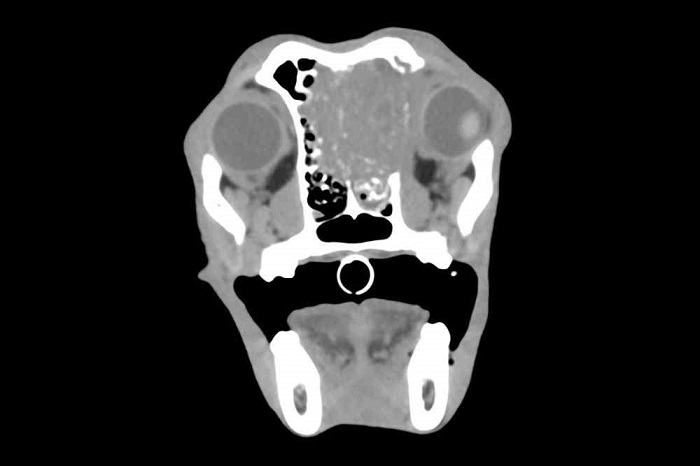A brain tumor in dogs refers to the uncontrolled growth of cells within the brain or its surrounding structures. Like in humans, brain tumors in dogs can be benign (non-cancerous) or malignant (cancerous). These tumors can originate from various types of cells within the brain, including neurons, glial cells (supporting cells in the nervous system), and meninges (the protective covering around the brain).
Causes of Brain Tumor in Dogs
The exact etiology of brain tumors in dogs is poorly understood, and they can develop for various reasons, some of which are still being researched. However, here are some potential factors that may contribute to the development of brain tumors in dogs:
- Genetics: There is a probability to suggest that genetics may contribute to the development of certain types of brain tumors in dogs. Certain breeds may be more predisposed to specific types of brain tumors, indicating a genetic component.
- Age: Brain tumors in dogs are more commonly diagnosed in older dogs. While they can occur at any age, older dogs are at a higher risk.
- Environmental Factors: Exposure to environmental toxins or carcinogens could sometimes be a risk factor. However, specific environmental causes have not been definitively identified.
- Radiation Exposure: Dogs that have undergone radiation therapy for other medical conditions may have an increased risk of developing brain tumors, although this is relatively rare.
- Immune System Function: Some research suggests that a weakened immune system may be associated with an increased risk of certain brain tumors in dogs. However, the exact relationship still needs to be fully understood.
- Viral Infections: In a few rare cases, viral infections have been linked to developing brain tumors in dogs. However, this is a rare cause.
- Idiopathic: In many cases, the actual cause of brain tumors in dogs remains unknown. These are referred to as idiopathic tumors, meaning their origin is unclear.
Types of Canine Brain Tumor
Brain tumors in dogs can vary in type and location within the brain. Here are some of the common types of brain tumors seen in dogs:
- Gliomas: These tumors originate from glial cells in the brain and are among dogs’ most common types of brain tumors. They can include astrocytomas and oligodendrogliomas. Gliomas can be both benign (low-grade) and malignant (high-grade).
- Meningiomas: Meningiomas are typically benign tumors that develop from the meninges, the protective membranes surrounding the brain. They often occur in older dogs and can often be surgically removed if they are not profoundly infiltrated into the brain.
- Choroid Plexus Tumors: Choroid plexus tumors develop from the choroid plexus, a brain structure producing cerebrospinal fluid. These tumors can be benign or malignant and may lead to increased intracranial pressure.
- Pituitary Tumors: These tumors originate in the pituitary gland at the brain’s base. Depending on the hormones involved, they can affect hormonal regulation and may result in various symptoms.
- Primary Brain Lymphoma: This type of lymphoma originates in the brain. It can be aggressive and affect other parts of the central nervous system.
- Metastatic Tumors: Cancer from other body parts can occasionally metastasize (spread) to the brain, resulting in secondary brain tumors.
- Oligodendrogliomas: These tumors arise from oligodendrocytes, which are another type of glial cell in the brain. They can be benign or malignant.
Clinical Signs of Brain Tumor in Dogs
Brain tumors in dogs can produce a wide range of clinical symptoms, which can differ depending on the type, size, location, and rate of growth of the tumor. Some common clinical signs of brain tumors in dogs include:
- Seizures: Seizures are one of dogs’ most common and prominent signs of a brain tumor. These seizures can manifest as mild tremors, twitching, or full-blown convulsions.
- Altered Behavior: Dogs with brain tumors may exhibit changes in behavior. This can include increased aggression, irritability, depression, or uncharacteristic docility.
- Circling or Head Tilt: Dogs with brain tumors may walk in circles or tilt their heads to one side due to disrupting normal brain function.
- Loss of Coordination: A brain tumor can affect a dog’s balance and coordination. You may notice stumbling, difficulty walking, or a drunken gait.
- Weakness or Paralysis: Depending on the tumor’s location, dogs may experience weakness or paralysis in certain limbs or on one side of the body.
- Altered Vision: Vision problems, such as dilated or unequal pupils, blindness, or abnormal eye movements (nystagmus), can occur with brain tumors.
- Altered Consciousness: Dogs may experience changes in consciousness, ranging from disorientation to coma.
- Appetite and Weight Changes: Some dogs with brain tumors may lose their appetite and experience weight loss.
- Difficulty Swallowing: Tumors in some brain regions can affect a dog’s swallowing ability, leading to drooling, choking, or regurgitation.
- Increased or Decreased Thirst and Urination: Depending on the tumor’s location, dogs may experience changes in their thirst and urination patterns.
Diagnosis of Canine Brain Tumor
Diagnosing a brain tumor in a dog typically involves a combination of clinical evaluation, advanced imaging, and sometimes additional tests. Here is an overview of the diagnostic process for brain tumors in dogs:
- Clinical Examination: The process often begins with a thorough clinical examination by a veterinarian. The vet will discuss the dog’s medical history and ask about any changes in behavior, seizures, or other symptoms.
- Neurological Evaluation: A neurological examination is critical to assess the dog’s neurological function. The veterinarian will evaluate reflexes, coordination, muscle strength, and cranial nerve function. Any abnormalities may provide clues to the presence and location of a brain tumor.
- Imaging Studies: Advanced imaging is the primary diagnostic tool for identifying dog brain tumors. Two common types of imaging studies used are:
- Magnetic Resonance Imaging (MRI): MRI is highly effective in providing detailed brain images. It can reveal the tumor’s size, location, and characteristics, helping with diagnosis and treatment planning.
- Computed Tomography (CT) Scan: CT scans can also provide detailed brain images and are sometimes used when MRI is not readily available or suitable.
- Cerebrospinal Fluid Analysis: A cerebrospinal fluid (CSF) analysis may sometimes be performed. This involves collecting a sample of the CSF to check for abnormalities, such as increased cell counts or elevated protein levels. It can help differentiate between certain types of brain tumors and other conditions.
- Biopsy: A brain biopsy may be recommended in cases where the imaging results are inconclusive or when the type of tumor needs to be determined for treatment planning. Biopsies can be obtained through surgical procedures, CT-guided biopsy, or, in some cases, by tapping the tumor with a needle.
- Blood Tests: Blood tests may be conducted to assess the dog’s overall health and rule out other underlying conditions contributing to the symptoms.
- Electroencephalogram (EEG): Sometimes, an EEG may record the brain’s electrical activity. It can help diagnose and characterize certain types of seizures or abnormal brain activity associated with tumors.
Treatment of Canine Brain Tumor
The treatment of canine brain tumors depends on several factors, including the type of tumor, its location, size, and the dog’s overall health. Standard treatment options for canine brain tumors include:
- Surgery: Surgical excision of the tumor is often the treatment of choice when the tumor is accessible and can be entirely removed without causing significant damage to critical brain structures. Some tumors, such as meningiomas, may be more amenable to surgical resection. Surgery can immediately relieve symptoms and potentially cure the dog if the tumor is benign and entirely removed.
- Radiation Therapy: Radiation therapy for brain tumors is a standard treatment for brain tumors in dogs, especially when complete surgical removal is not possible or the tumor is inoperable. Radiation therapy can help shrink the tumor, control its growth, and alleviate symptoms. It may be delivered as external beam radiation or, in some cases, stereotactic radiosurgery (SRS).
- Chemotherapy: Chemotherapy may be used alone or in combination with other treatments, such as radiation therapy. Chemotherapy drugs can help slow the growth of certain types of brain tumors, especially malignant ones. They may be administered orally or intravenously.
- Palliative Care: In cases where curative treatment is not possible or when a dog has advanced disease, palliative care aims to improve the dog’s quality of life and manage symptoms. This may include medications to control seizures, manage pain, reduce brain swelling, and alleviate other symptoms.
- Supportive Care: Supportive care is essential to address any treatment side effects and maintain the dog’s overall well-being. This can include nutritional support, hydration, and medications to manage side effects.
- Monitoring and Follow-Up: Dogs with brain tumors require ongoing monitoring and follow-up care. This includes regular veterinary check-ups, imaging studies (such as MRI or CT scans) to assess tumor response to treatment and adjustments to the treatment plan as needed.
Prognosis of Brain Tumor in Dogs
The fate of a dog with a brain tumor can vary significantly depending on several factors, including the type of tumor, its location, size, grade (if applicable), and the stage of the disease at the time of diagnosis. Additionally, the age and overall health of the dog play a vital role in determining the prognosis. Here are some general considerations:
- Tumor Type: The specific type of brain tumor is a critical factor in the prognosis. Some tumors, such as benign meningiomas, have a better prognosis than malignant gliomas.
- Tumor Location: The tumor’s location within the brain can impact the prognosis. Tumors that are in surgically accessible areas may have a better prognosis if they can be removed entirely.
- Tumor Size: Smaller tumors are generally associated with a better prognosis than larger ones. Large tumors can pressure surrounding brain structures, causing more severe neurological symptoms.
- Grade: If the tumor is malignant, its grade (low-grade or high-grade) can affect the prognosis. High-grade tumors are typically more aggressive and carry a poorer prognosis.
- Stage: The stage of the disease at the time of diagnosis is essential. Early detection and treatment result in better outcomes.
- Age and Health of the Dog: Older dogs or those with other health issues may have a lower tolerance for aggressive treatments like surgery or radiation therapy. The overall health and strength of the dog can influence the ability to tolerate treatments and recover.
- Response to Treatment: The response to treatment, whether it’s surgery, radiation therapy, chemotherapy, or a combination, can significantly impact the prognosis. A positive response to treatment may extend the dog’s life and improve its quality of life.
- Palliative Care: In cases where curative treatment is not possible, palliative care can help manage symptoms and maintain the dog’s comfort and quality of life.
Concluding Words on Brain Tumor in Dogs
In conclusion, brain tumors in dogs are complex and potentially severe medical conditions that can affect dogs of any age and breed. While the exact causes are unclear, early detection is crucial for improving affected dogs’ prognosis and quality of life.
Common signs of brain tumors in dogs include seizures, changes in behavior, coordination problems, and more. Diagnostic procedures such as MRI or CT scans, neurological evaluations, and sometimes biopsies or cerebrospinal fluid analysis are used to confirm the diagnosis.
Treatment options for canine brain tumors vary and may include surgery, radiation therapy, chemotherapy, or palliative care, depending on factors like tumor type, location, and the dog’s overall health. The choice of treatment is typically tailored to the individual dog’s needs.

